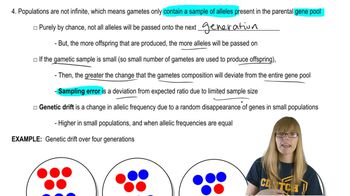How do geneticists detect the presence of genetic variation as different alleles in a population?
Table of contents
- 1. Introduction to Genetics51m
- 2. Mendel's Laws of Inheritance3h 37m
- 3. Extensions to Mendelian Inheritance2h 41m
- 4. Genetic Mapping and Linkage2h 28m
- 5. Genetics of Bacteria and Viruses1h 21m
- 6. Chromosomal Variation1h 48m
- 7. DNA and Chromosome Structure56m
- 8. DNA Replication1h 10m
- 9. Mitosis and Meiosis1h 34m
- 10. Transcription1h 0m
- 11. Translation58m
- 12. Gene Regulation in Prokaryotes1h 19m
- 13. Gene Regulation in Eukaryotes44m
- 14. Genetic Control of Development44m
- 15. Genomes and Genomics1h 50m
- 16. Transposable Elements47m
- 17. Mutation, Repair, and Recombination1h 6m
- 18. Molecular Genetic Tools19m
- 19. Cancer Genetics29m
- 20. Quantitative Genetics1h 26m
- 21. Population Genetics50m
- 22. Evolutionary Genetics29m
21. Population Genetics
Allelic Frequency Changes
Problem 3
Textbook Question
Identify and describe the evolutionary forces that can cause allele frequencies to change from one generation to the next.
 Verified step by step guidance
Verified step by step guidance1
Understand that evolutionary forces are mechanisms that cause changes in allele frequencies within a population over generations, leading to evolution.
Identify the main evolutionary forces: natural selection, genetic drift, gene flow (migration), mutation, and non-random mating.
Describe natural selection as the process where alleles that confer a survival or reproductive advantage increase in frequency because individuals with those alleles are more likely to survive and reproduce.
Explain genetic drift as random fluctuations in allele frequencies due to chance events, which are especially significant in small populations.
Discuss gene flow as the movement of alleles between populations through migration, which can introduce new alleles or change allele frequencies in a population.
 Verified video answer for a similar problem:
Verified video answer for a similar problem:This video solution was recommended by our tutors as helpful for the problem above
Video duration:
2mPlay a video:
Was this helpful?
Key Concepts
Here are the essential concepts you must grasp in order to answer the question correctly.
Natural Selection
Natural selection is the process where individuals with advantageous traits have higher survival and reproduction rates, causing those alleles to increase in frequency over generations. It drives adaptation by favoring beneficial genetic variations in a population.
Recommended video:
Guided course

Natural Selection
Genetic Drift
Genetic drift refers to random changes in allele frequencies due to chance events, especially in small populations. It can lead to the loss or fixation of alleles independently of their selective advantage, reducing genetic variation over time.
Recommended video:
Guided course

Genetic Drift
Gene Flow
Gene flow is the movement of alleles between populations through migration or interbreeding. It introduces new genetic material, which can alter allele frequencies and increase genetic diversity within a population.
Recommended video:
Guided course

Mapping Genes
Related Videos
Related Practice
Textbook Question
567
views


